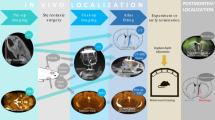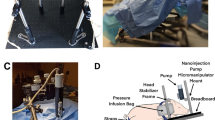Abstract
In the past decade, the New World common marmoset (Callithrix jacchus) has taken a seminal position in neurobiological research, fueled in part by its smooth cortical sheet, which allows cortical areas to be easily accessed by current technologies on the dorsal surface of the brain. In this protocol, we describe a method for the precision placement of agents (e.g., tracers or neurotoxins) into small brain regions of the infant and adult marmoset, using an MRI-guided approach. This strategy uses a protocol for prolonged anesthesia without the need for intubation that we have recently developed, alongside appropriate analgesia and monitoring. The protocol can be readily adapted to be used together with advanced research techniques, such as two-photon microscopy and optical imaging. Including a 5-d postoperative care plan, this protocol takes 7 d to complete. The protocol requires a team of personnel experienced in marmoset care and handling, and small-animal neurosurgery; an assistant for monitoring the animal and assisting with anesthesia; and an MRI technician.
This is a preview of subscription content, access via your institution
Access options
Subscribe to this journal
Receive 12 print issues and online access
$259.00 per year
only $21.58 per issue
Buy this article
- Purchase on Springer Link
- Instant access to full article PDF
Prices may be subject to local taxes which are calculated during checkout





Similar content being viewed by others
References
Missler, M. et al. Developmental biology of the common marmoset: proposal for a 'postnatal staging'. J. Med. Primatol. 21, 285–298 (1992).
Schultz-Darken, N., Braun, K.M. & Emborg, M.E. Neurobehavioral development of common marmoset monkeys. Dev. Psychobiol. 58, 141–158 (2016).
Sasaki, E. et al. Generation of transgenic non-human primates with germline transmission. Nature 459, 523–527 (2009).
Sasaki, E. Prospects for genetically modified non-human primate models, including the common marmoset. Neurosci. Res. 93, 110–115 (2015).
Rensing, S. & Oerke, A.-K. Husbandry and management of New World species: marmosets and tamarins. Lab. Primate 145–162 (2005).
Flecknell, P.A. 7 - Anaesthesia of common laboratory species. In Laboratory Animal Anaesthesia 2nd edn. (ed. Flecknell, P.A.) 159–223 (Academic Press, 1996).
Whelan, G., James, M.F., Samson, N.A. & Wood, N.I. Anaesthesia of the common marmoset (Callithrix jacchus) using continuous intravenous infusion of alphaxalone/alphadalone. Lab. Anim. 33, 24–29 (1999).
Bakker, J. et al. Comparison of three different sedative-anaesthetic protocols (ketamine, ketamine-medetomidine and alphaxalone) in common marmosets (Callithrix jacchus). BMC Vet. Res. 9, 113 (2013).
Warner, C.E. et al. Preservation of vision by the pulvinar following early-life primary visual cortex lesions. Curr. Biol. 25, 424–434 (2015).
Warner, C.E., Kwan, W.C. & Bourne, J.A. The early maturation of visual cortical area MT is dependent on input from the retinorecipient medial portion of the inferior pulvinar. J. Neurosci. 32, 17073–17085 (2012).
Teo, L. & Bourne, J.A. A reproducible and translatable model of focal ischemia in the visual cortex of infant and adult marmoset monkeys. Brain Pathol. 24, 459–474 (2014).
Mitchell, J.F., Reynolds, J.H. & Miller, C.T. Active vision in marmosets: a model system for visual neuroscience. J. Neurosci. 34, 1183–1194 (2014).
Mitchell, J.F. & Leopold, D.A. The marmoset monkey as a model for visual neuroscience. Neurosci. Res. 93, 20–46 (2015).
Marmoset Genome, S. & Analysis, C. The common marmoset genome provides insight into primate biology and evolution. Nat. Genet. 46, 850–857 (2014).
Paxinos, G., Watson, C., Petrides, M., Rosa, M.G. & Tokuno, H. The Marmoset Brain in Stereotaxic Coordinates 1st edn., 324 (Elsevier Academic Press, 2012).
Stephan, H., Baron, G. & Schwerdtfeger, W.K. The Brain of the Common Marmoset (Callithrix jacchus) 1st edn. (Springer-Verlag, 1980).
Palazzi, X. & Bordier, N. The Marmoset Brain in Stereotaxic Coordinates 1st edn., IV, 60, (Springer-Verlag, 2008).
Tokuno, H., Tanaka, I., Umitsu, Y., Akazawa, T. & Nakamura, Y. Web-accessible digital brain atlas of the common marmoset (Callithrix jacchus). Neurosci. Res. 64, 128–131 (2009).
Newman, J.D. et al. A combined histological and MRI brain atlas of the common marmoset monkey, Callithrix jacchus. Brain Res. Rev. 62, 1–18 (2009).
Krauze, M.T. et al. Reflux-free cannula for convection-enhanced high-speed delivery of therapeutic agents. J. Neurosurg. 103, 923–929 (2005).
Gill, T. et al. In vitro and in vivo testing of a novel recessed-step catheter for reflux-free convection-enhanced drug delivery to the brain. J. Neurosci. Methods 219, 1–9 (2013).
Acknowledgements
We would like to thank W. Kwan and Q. Wu for their assistance with surgeries and imaging, respectively, and A. Gibbon and T. Tecirlioglu for their assistance with the postsurgical monitoring sheet. The Australian Regenerative Medicine Institute is supported by grants from the State Government of Victoria and the Australian Government. This work was supported by an NHMRC Project Grant (APP1042893) and by ARC SRI (Stem Cells Australia). J.A.B. is supported by an NHMRC Senior Research Fellowship (APP1077677).
Author information
Authors and Affiliations
Contributions
I.-C.M. designed the MRI-guided protocol, performed the surgeries and wrote the manuscript; P.A.F. co-designed the anesthesia regimen and edited the manuscript; J.A.B. mentored the other authors, designed the protocol, obtained funding, performed the surgeries and wrote the manuscript.
Corresponding author
Ethics declarations
Competing interests
The authors declare no competing financial interests.
Supplementary information
Supplementary Table 1
Supplementary Table 1 (PDF 144 kb)
Supplementary Data 1
Supplementary Data 1 - 3D facemask (ZIP 240 kb)
Supplementary Data 2
Supplementary Data 2 - 3D facemask (PDF 178 kb)
Rights and permissions
About this article
Cite this article
Mundinano, IC., Flecknell, P. & Bourne, J. MRI-guided stereotaxic brain surgery in the infant and adult common marmoset. Nat Protoc 11, 1299–1308 (2016). https://doi.org/10.1038/nprot.2016.076
Published:
Issue Date:
DOI: https://doi.org/10.1038/nprot.2016.076
This article is cited by
-
Mapping the neural circuitry of predator fear in the nonhuman primate
Brain Structure and Function (2021)
-
Retinal ganglion cells projecting to superior colliculus and pulvinar in marmoset
Brain Structure and Function (2021)
-
Targeted Patching and Dendritic Ca2+ Imaging in Nonhuman Primate Brain in vivo
Scientific Reports (2017)
Comments
By submitting a comment you agree to abide by our Terms and Community Guidelines. If you find something abusive or that does not comply with our terms or guidelines please flag it as inappropriate.



